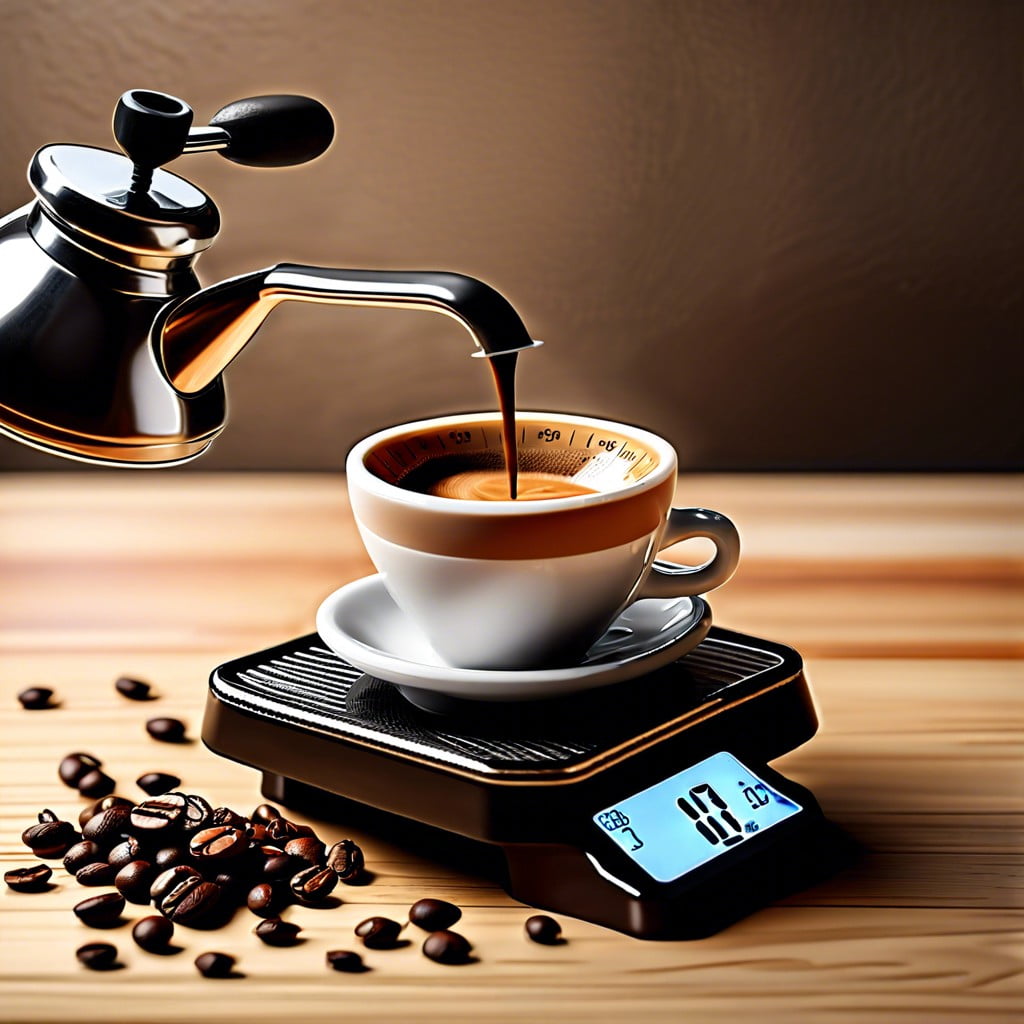Discover the significance of the coffee to water ratio and how it can transform your brewing experience for a perfect cup every time.
Coffee to Water Ratio Calculator

Nailing the coffee to water ratio is like finding the sweet spot on a baseball bat—when you hit it, it’s a home run. A calculator for this ratio takes the guesswork out of brewing. For the mathematically disinclined, fear not—this is no advanced calculus. Just input the desired number of cups, and voila, the calculator does the heavy lifting, offering the precise amount of coffee and water needed.
Precision here is key, because even a slight deviation can be the difference between a transcendental coffee experience and a lackluster morning cup. It’s a simple tool that adjusts the coffee strength to personal preference while maintaining balance. Trust in technology to elevate that cup of joe from good to great without the trial-and-error of yesteryears.
Coffee Ratios for Different Brewing Methods
Different brewing methods dance to their own tunes. Where one method may prefer a tango of stronger flavor, another opts for the waltz of subtlety. Here’s the lowdown on how ratios play their part:
Drip or Pour-over: Start with a 1:17 ratio. For every gram of coffee, add 17 grams of water. This method forgives a bit of wiggle room, so feel free to adjust to your taste buds’ content.
French Press: It likes it rich and full-bodied, so a 1:15 ratio will do the trick. Be bold; let the coffee steep in the hot water and relish the hearty flavor.
Espresso: It’s all about precision – think a hawk eyeing its prey. A 1:2 ratio does wonders here. For every gram of coffee, coax out two grams of liquid gold.
Cold Brew: Patience is a virtue with this slow-brewing method. A 1:5 ratio sets the stage for a concentrate you can dilute later. Plan ahead; your future self will thank you.
Remember, these ratios serve as starting blocks. Your taste should be the judge; don’t be afraid to tweak the numbers. Experimentation is the spice of coffee brewing.
Understanding Coffee Brewing Ratios
Dialing in the right coffee to water ratio is like finding the sweet spot on a baseball bat – it can make all the difference between a mediocre swing and a home run cup. Essentially, this ratio dictates the concentration and strength of your brew.
Crafting a cup of coffee is less about strict rules and more about personal taste, testing the waters to discover your ideal strike zone. A general guideline to abide by is the “Golden Ratio” – one to two tablespoons of ground coffee for every six ounces of water. This can serve as your compass, but let’s not forget that each brewing method may have its own ratio MVP.
Automatic drip brew systems forgive many sins and often thrive with a 1:15 coffee-to-water ratio. However, pour-over aficionados may gravitate towards a 1:17 ratio for that clean, intricate dance of flavors. Meanwhile, if you seek the bold embrace of a French press, a ratio closer to 1:12 stands up to the task.
Remember, ratios aren’t set in stone. The real magic happens through experimentation – adjusting until every sip feels like the warm embrace of an old friend. So grab your measuring tools, trust your taste buds, and play ball with coffee ratios. Your perfect morning brew might just be one tweak away.
Tips for Brewing the Perfect Cup of Coffee
Precision is your friend. Invest in a digital scale to weigh your coffee and water. This eliminates guesswork and ensures consistency cup after cup.
Grind size matters. A fine grind suits methods like espresso, while coarser grinds are perfect for French press brewing. Match your grind to your brewing method for optimal extraction.
Quality water is a non-negotiable. Use fresh, filtered water to avoid off-flavors. Remember, coffee is over 98% water, so the quality of water can make or break your brew.
Pre-infusion, or the bloom, is a crucial step, especially for pour-overs and other drip methods. Pour a little hot water over the grounds to let them swell, release gases, and prepare for even extraction.
Temperature control is critical. Aim for a water temperature between 195°F and 205°F to effectively extract flavors without scalding your beans.
Stirring can make a difference. A gentle stir ensures all grounds are wet and can aid in achieving a uniform extraction.
Be consistent with your method once you find the ratio and technique that delights your palate. Record your successful recipes and replicate them for future brewing bliss.
Tools for Achieving the Perfect Coffee to Water Ratio
Dialing in the optimal coffee to water ratio breathes life into your brew, enhancing flavor profiles and overall satisfaction. Let’s shine a spotlight on some trusty gadgets that aid in this quest:
- A Digital Scale: Precision is key. A gram off can sway the taste. A digital scale lends accuracy to your measurements, ensuring that you strike the right balance every time.
- Measuring Spoons: If a scale isn’t within reach, measuring spoons can serve as a proxy. Keep in mind that coffee density can vary, so this isn’t the gold standard, but it’s better than eyeballing.
- Grinders with Weight-Based Dosing: Some grinders come equipped with technology to grind by weight, directly into your portafilter or brewing device. This convergence of grinding and measuring streamlines the process.
- Smartphone Apps: For the tech-savvy, apps exist that can calculate ratios, offer brewing tips, and even time your brewing process.
- Water Temperature Tools: Temperature affects solubility and extraction. A thermometer or a variable temperature kettle can be an ally in hitting that sweet spot.
- Remember, even small adjustments can profoundly affect your cup’s character, so employing the right tools not only simplifies the journey but also elevates the outcome.